
2011 1st Issue
Feature Articles
(I) Green Lunch In School
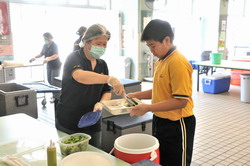
To reduce waste, promote healthy living and inculcate the value of caring for the environment among students, the Government has invited all schools to sign a Green Lunch Charter. Participating schools have pledged to adopt on-site meal portioning and use reusable food containers and cutlery.
At present, lunches in most schools are provided by lunch suppliers. The suppliers should adopt the following food safety and hygiene measures to reduce the risk of food poisoning.
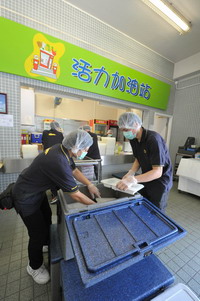 Facilities
Facilities
- Ensure that adequate facilities, such as stove, refrigerator and heat-holding equipment are available.
- Purchase and receipt of ingredients
- Purchase ingredients from reliable suppliers.
- Check the quality of the ingredients upon receipt.
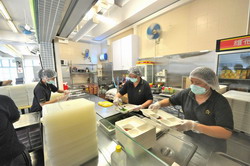 Storage facilities and temperature control
Storage facilities and temperature control
- Stick to the "first-in-first-out" principle for food use.
- Check and record the temperature of refrigerators regularly. Maintain the temperature of chillers at 4oC or below and freezers at -18oC or below.
- Food should be stored in impervious containers wrapped with cling wrap or covered.
- Raw and cooked foods should be kept in separate refrigerators. If they are to be stored in the same refrigerator, put cooked foods on upper shelves and raw ones on lower shelves to prevent cross-contamination.
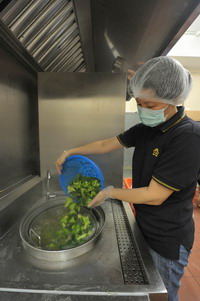 Food handling and cooking
Food handling and cooking
- Before cooking, defrost frozen food in a chiller or under running water.
- Cook thoroughly. Use a thermometer to check if the centre temperature of the food reaches 75oC or above.
- Cooking area, reheating area, food storerooms and toilets are kept clean and free from pest infestation.
- All food contacting utensils, including reusable lunch boxes and tableware, are clean, sterilised and properly stored.
- Ensure that all vehicles for the delivery of food are kept clean and hygienic.
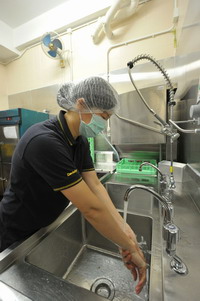 Maintaining good personal hygiene
Maintaining good personal hygiene
- Before handling food and after using toilets, wash hands with liquid soap for at least 20 seconds, rinse thoroughly and then wipe or blow-dry the hands.
- Food handlers with symptoms such as diarrhoea and vomiting should not handle food.
- Handling contaminated food
- Develop a contingency plan for food poisoning incident in advance.
- When problems are identified, ask other schools to stop eating the food immediately to prevent further food incidents.
- Maintain the following records at all times to facilitate follow-up actions on food poisoning or other food incidents:
- list of schools to which meals are provided everyday (with information such as the types of food provided);
- list of ingredient suppliers;
- daily purchase record.
- If irregularities are identified, stop distributing the food immediately and take follow-up and remedial actions.
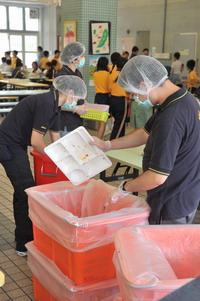
Suppliers should take the following measures if food is portioned on site:
- Cooked foods are stored in heat-insulating containers and kept at or above 60oC.
- Chilled foods that require reheating are thoroughly reheated until the centre temperature reaches 75oC or above for at least 30 seconds.
- Chilled foods are kept at 4oC or below.
- There are adequate space, equipment (e.g. food warming devices) and manpower to maintain cleanliness and to portion and distribute the food efficiently.
- Food temperature is sampled before distributing the food. Hot foods are kept above 60oC and chilled foods at 4oC or below.
- Trash is properly disposed of to prevent pest infestation.
(II) Methods to Reduce Acrylamide in Food
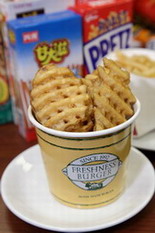
Acrylamide is a toxic and carcinogenic chemical that is found in many types of food. Research findings revealed that raw food and foodstuffs that are prepared by boiling do not contain high levels of acrylamide. Acrylamide is formed when food, particularly those rich in carbohydrate such as potato chips, crisps, breakfast cereals products and cookies are cooked at above 120oC.
To reduce acrylamide in food, the trade should not cook food excessively, i.e. for too long or at too high temperature, and should reduce the provision of fried and fatty foods. However, all food (particularly meat and meat products) should be cooked thoroughly to destroy foodborne pathogens. For further information, please browse the following web sites:
http://www.cfs.gov.hk/english/programme/programme_rafs/files/ras_acrylamide_2.pdf
http://www.cfs.gov.hk/english/programme/programme_rafs/
programme_rafs_fc_01_29_Acrylamide_in_Some_Popular_Foods.html
Readers' Corner
(I) Enhance Food Traceability Strengthen Food Safety
Food Safety Ordinance
The Food Safety Ordinance (the Ordinance) was passed by the Legislative Council on 30 March 2011 and will commence on 1 August 2011. The Ordinance introduces a food tracing mechanism to help the Government trace the source of the food more effectively and take prompt action when dealing with food incidents. The food tracing mechanism includes:
- a registration scheme for food importers and distributors; and
- a requirement for food traders (including food importers, distributors and retailers) to keep records relating to movement of food.
There is a six-month grace period for the two requirements, which will end on 31 January 2012. Members of the trade may visit the dedicated web site of the Ordinance (www.foodsafetyord.gov.hk) to obtain more information.
Registration Scheme for Food Importers and Food Distributors
Under this Registration Scheme, all food importers and distributors are required to register with the Director of Food and Environmental Hygiene, except those who have already registered or have obtained a licence under other ordinances (listed at Schedule 1 of the Food Safety Ordinance). The fee levels for registration and renewal of registration for a three-year term are $195 and $180 respectively. Members of the trade may refer to the Guide to the Registration Scheme for Food Importers and Food Distributors on the dedicated web site for details.
Food importers and distributors may submit their applications in written form or by electronic means. Application forms can be downloaded from the dedicated web site or obtained from the following office:
Food Importer / Distributor Registration and Import Licensing Office
Food Import & Export Section,
Centre for Food Safety,
Food and Environmental Hygiene Department
(II) "Organic" Food
Uncle Lam is getting old and he intends to pass the grocery store he has been operating for more than thirty years to his son, Fred. However, Uncle Lam wants to give Fred a test to see if Fred is capable of running the store.
| Uncle Lam: |
Fred, if I want to open a branch, what kind of business should we do?
|
 |
|
| Fred: |
Dad, are you planning to open a branch?
|
||
| Uncle Lam: |
I said if … …, just if a branch will be opened, what business should we operate?
|
||
| Fred: |
If a branch is to be opened, I suggest setting up an organic food store targeting middle class clientele.
|
||
| Uncle Lam: |
Organic food store? What is it?
|
||
| Fred: |
Organic food refers to food that is produced according to organic standards throughout production, handling, processing and marketing, and certified as organic food by a certification body or authority of the country of origin.
|
||
| Uncle Lam: |
What are you talking about? I can't get it unless you explain it in detail.
|
||
| Fred: |
Ok, ok. The purpose of organic production is to ensure that the production of food is kept "natural". For example, the use of chemical fertilisers and pesticides is avoided in planting. Farming, manures, hand weeding and biological pest control are adopted instead. The use of antibiotics, growth hormones and other feed additives is avoided in raising animals. In addition, no genetic modification and ionising radiation is applied in the entire food production process. Furthermore, personnel from independent certification bodies will conduct regular inspections for certification to ensure that the organic production standards have been followed throughout the production, handling, processing and marketing of organic food. Only certified food can be marked as "organic" for sale.
|
 |
|
| Uncle Lam: |
So, there are stringent production standards for organic food. However, how can we make sure that the products we get from the suppliers are "organic"?
|
||
| Fred: |
Now there are many kinds of organic food products in the market. In Hong Kong, the organic food produced is mainly vegetables. Regarding processed organic food products, such as prepackaged dried fruits, soya milk, eggs and meat, etc, they are mainly imported from overseas. When we place orders, we can request the producers or importers to provide the certification issued by the certification bodies or authorities to ensure that the products meet the organic standards throughout production and processing.
|
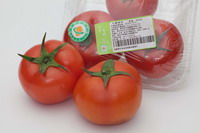 |
|
| Uncle Lam: |
Good! We can obtain such products for sale, but will people buy them?
|
||
| Fred: |
Many people are concerned about environmental protection and health nowadays. Some believe that organic production is better for the environment and animal welfare and others think that eating organic food can prevent the intake of pesticide residues and additives. These people are willing to pay a bit more for organic food. If the sources of organic food products are well-controlled, there is no need to worry about the business.
|
||
| Uncle Lam: |
Well, how can customers know that our products are organic food?
|
||
| Fred: |
Products that have been certified by the certification bodies or authorities as organic food usually bear the approved labels or indications such as "certified by xxx" (xxx refers to the name of the certification body). In addition, some processed food may be partially made with organic materials. They may be labelled as "Made with Organic xxx" (xxx refers to the name of the organic materials). Therefore, when making purchases, customers can identify such food simply by reading the labels on the packages of the products.
|
||
| Uncle Lam: |
I see, you have a good knowledge of organic food. If I hand over this grocery store to you, do you have confidence that you can change it into an organic food store?
|
||
| Fred: |
Sure! Dad, trust me … … I will run it well!
|
(III) Oxalate Acid Food Poisoning
There have been food poisoning cases resulting from the consumption of vegetables. After investigation, it was suspected that the vegetables might have been mixed with a small amount of oxalates-containing plants, thus causing food poisoning.
Oxalate acid and oxalates (such as sodium oxalate, potassium oxalate, ammonium oxalate, calcium oxalate, iron oxalate and magnesium oxalate) occur naturally in certain plants and vegetables, but their usual content levels are not high and they are seldom associated with food poisoning. Oxalate acid, sodium oxalate, potassium oxalate and ammonium oxalate are water soluble while calcium oxalate, iron oxalate and magnesium oxalate are water insoluble. A number of studies have shown that whether oxalates in plants will cause food poisoning depends on the level of needle-shaped calcium oxalate which is water insoluble.
People who consume plants with high level of water insoluble needle-shaped calcium oxalate (such as wild taro) may develop symptoms of food poisoning such as numbness and swelling over lips, burning sensation around mouth and in the throat.
To reduce oxalate acid food poisoning due to the mix of vegetables and other plants, the trade should purchase vegetables from reliable suppliers, wash vegetables thoroughly before cooking and remove any plants mixed with the vegetables.
(IV) Safe Use of Melamine-ware
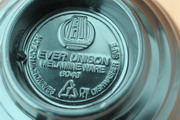
Tableware products made of melamine-formaldehyde resins are generally described as melamine-ware. Owing to their strong durability, good chemical and heat resistance and low cost, melamine-ware products are widely used in Hong Kong and around the world. However, improper use and poor-quality of melamine-ware will lead to leaching out of excessive amount of formaldehyde or melamine and migration of formaldehyde or melamine residues into the foodstuff, thus posing threats to food safety. The Centre for Food Safety (CFS) has therefore conducted a study to examine the level of formaldehyde and melamine migration from melamine-ware available for use on local food premises in order to assess the safety of these products. The test results of all melamine-ware samples taken in the study were satisfactory, indicating that these products are safe for use. The full report of the study has been uploaded on the following web site:
http://www.cfs.gov.hk/english/programme/programme_rafs/
files/RA_Study_on_Melamineware_Final_Report_Nov2010_e.pdf
To ensure food safety, please refer to the following advice when using melamine-ware:
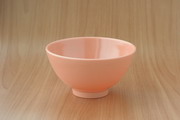
Advice to Food Business
- Restaurants and food businesses should obtain melamine-ware from reliable manufacturers and suppliers and use melamine-ware of suitable quality to serve food to customers.
- Use melamine-ware according to the product specifications and instructions.
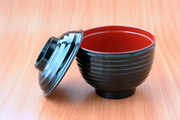
Advice to Manufacturers and Suppliers
- Manufacturers should adopt good manufacturing practices in making melamine-ware for food use.
- Manufacturers are advised to provide instructions on its intended use.
- Suppliers should obtain melamine-ware products from reliable manufacturers and ensure the products are of suitable quality for food use.
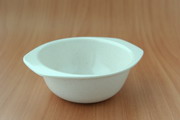
General Advice for Using Melamine-ware
- Use melamine-ware according to product specifications and instructions.
- Do not use melamine-ware that is broken or damaged on its surface.
- Do not heat or cook food in melamine-ware.
- Do not use melamine-ware in microwave oven or conventional oven.
- Do not use melamine-ware to hold hot oil or highly acidic food.
- If melamine-ware is to be used for holding hot deep-fried food, cool the food down before putting it in the melamine-ware.
- For cleaning, do not use abrasive detergent and cleaning tools or strong chemicals which will damage the surface.
News on New Dishes
Safety tips on preparing Baked Scallop with Cheese
To continue with News on New Dishes for this issue, we interviewed another Signatory of the Food Safety Charter - Satay King. Baked Scallop with Cheese is one of Satay King's house specials. What actually are the tips for preparing this dish? Satay King's Kitchens Manageress Miss Janet Cheung told us that it is a prepared-when-ordered dish and the steps and tips for preparing this dish are as follows:
| How to Prepare | Tips | |
|---|---|---|
Receiving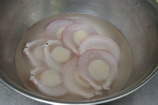 |
First of all, buy good quality scallops and store them properly. Before preparing the scallops, wash them thoroughly. | Buy scallops from a licensed or approved supplier. Carefully inspect the scallops received. Apply the first-in-first-out principle when consuming the scallops to ensure good quality. |
Blanching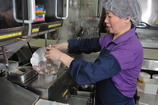 |
After washing, blanch scallops in boiling water until cooked. | Stick to the blanching time as specified in the directive for preparing scallops to ensure that the food is thoroughly cooked. |
Arranging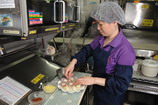 |
Put mashed potato with cream on a plate and then arrange the cooked scallops on top of the potato and add cheese and small pieces of bacon. | To achieve perfect colour, aroma and taste, choose good quality cheese and bacon. |
Baking |
Bake the scallops in the oven until golden brown. Put them on a serving plate and serve immediately. | Make sure the preset baking time and temperature are correct. |
Pledges of Satay King:
-
Quality ingredients are of prime importance. Choose a licensed or approved supplier and inspect the health certificates for food. Inspect the food received and adopt the first-in-first-out principle for consumption of food to ensure food quality and hygiene.
-
Lay down a code of food hygiene and work procedures for staff to follow. Provide training for all the staff to ensure that they understand the hygiene code and work procedures.
-
Have in place a rigorous monitoring system to ensure food hygiene and environmental cleanliness.
-
Observe the principle of separate storage and preparation of raw food and cooked food (e.g. use different labelled utensils for handling raw food and cooked food to avoid cross contamination).
-
Provide directives for cooking time and temperature for all dishes to ensure that food is thoroughly cooked.
-
Equip the restaurant with a big refrigerated room for storing food. Temperature of the refrigerated room is checked and recorded by a cook every day to ensure that it functions properly.
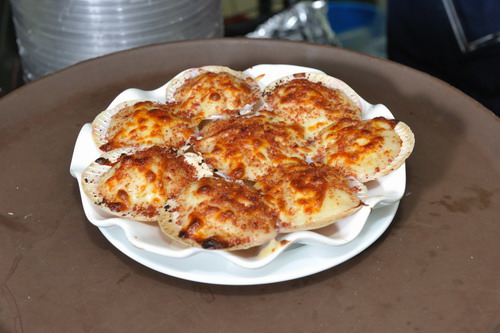
Briefing of Activities
(I) Technical Meeting with Trade on Proposed Regulatory Framework for Pesticide Residues in Food
To facilitate effective control of pesticides in food, the Centre for Food Safety (CFS) held a technical meeting with the trade on the "Proposed Regulatory Framework for Pesticide Residues in Food" on 21 January 2011. At the meeting, members of the trade discussed related issues and also expressed plenty of valuable opinions. The CFS would like to thank the trade for their enthusiastic participation in the meeting.
(II) Workshop on Nutrition Labelling Scheme

Over the past two years, the CFS conducted a total of 25 Workshops on Nutrition Labelling Scheme (including Basic and Advanced Workshops). The trade's enrolment was overwhelming and valuable feedback from them was received. On 20 January 2011, the CFS conducted another Basic Workshop on Nutrition Labelling Scheme to enable members of the trade to have a deeper understanding of how to prepare nutrition labels.
(III) Promotion of Nutrition Labelling Scheme

On 23-24 December 2010, the CFS set up a games booth and organised an exhibition to promote nutrition labelling at the 45th Hong Kong Brands and Products Expo. The CFS would like to thank the public for their enthusiastic participation and support on both days. To boost the promotion of nutrition labelling, the CFS will, apart from continuing to hold roving exhibitions at various venues across the territory, also hold exhibitions at public libraries. For details, please visit the web site of the CFS.
Food Safety Q&A
Do we need to add preservatives to all prepackaged food?
Preservatives are added to food to protect it against deterioration, hence prolonging the shelf-life of food. Preservatives are capable of preventing or retarding the growth of micro-organisms, such as moulds, yeasts and bacteria in food. Preservatives can also reduce the effect of pathogenic micro-organisms on food, which helps safeguard food safety.
During the processing of prepackaged food, preservatives are added to inhibit the growth of spoilage and pathogenic micro-organisms in the food. Therefore, in general, prepackaged food available on the market has relatively longer shelf-life as compared with the same kind of food in the fresh state. Besides, there are other food processing procedures or packaging methods that have the same effect of prolonging the shelf-life of food.
Yet, adding preservatives is not the only way to preserve food. Pasteurisation can be used to preserve fresh milk which can deteriorate easily due to its naturally high bacterial level. By reducing the bacteria count in milk, pasteurisation can achieve the purpose of disinfection of milk but no preservative is used. After treatment and packaging, milk can have a longer shelf-life if it is stored at an appropriate temperature. By applying ultra high temperature treatment to the food to reduce its bacteria count and storing the food in can right after the treatment, some food can also be preserved without using preservatives. Provided that its package remains intact, such food enjoys a longer shelf-life even though it is stored at room temperature.
Truth against Fallacy
Are soybean milk and food nutritious and suitable for everyone?
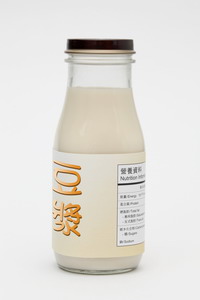
In recent years, urban people have been keen on having a healthy diet. Soybean products, which are rich in nutrition and can help prevent cardiovascular diseases, are considered healthy food. The findings of studies show that soybean milk can effectively lower blood fat, prevent arteries from hardening and reduce the risk of getting chronic illnesses related to blood vessels of the brain and heart. Besides, the isoflavones in soybeans help prevent osteoporosis and cancers.
However, soybeans in fact contain various kinds of harmful substances. The phytic acid content in soybeans is several times higher than that of all seeds, nuts and pods. Phytic acid will mix with certain essential minerals such as calcium, magnesium, iron, copper and zinc in the food passing the intestine and form plant salt which is water insoluble and cannot be taken in by the body, thus preventing the intake of essential minerals in intestine. Soybeans also contain trypsin inhibitor which hampers digestion and intake of protein, causing excessive gas and indigestion.
To reduce the impacts of these harmful substances in soybeans, the trade is advised to soak and cook the beans in boiling water thoroughly before preparing them.
Brain Gym
Siu Ming goes to supermarket to buy biscuits for his grandfather who has high blood pressure and should avoid food with high salt content.
Siu Ming finds two brands of biscuits. However, the nutrient information on their nutrition labels is set out in different ways and Siu Ming has no idea how to compare the content of nutrients in these two biscuit products. Which brand do you think he should choose for his grandfather?
Brand A biscuit
| Nutrition Information 營養資料 | |
|---|---|
|
Per 100 g/每100克
|
|
| Energy/能量 |
218 kcal/千卡
|
| Protein/蛋白質 |
5.5 g/克
|
| Total fat/總脂肪 |
8 g/克
|
| -Saturated fat/飽和脂肪 |
3.5 g/克
|
| -Trans fat/反式脂肪 |
0 g/克
|
| Carbohydrates/碳水化合物 |
32 g/克
|
| -Sugars/糖 |
1 g/克
|
| Sodium/鈉 |
365 mg/毫克
|
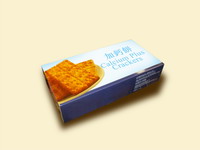
Brand B biscuit
| Nutrition Information 營養資料 | |
|---|---|
| Servings Per Package/每包裝含食用分量數目: 8 Serving Size/食用分量: 3 pieces(30 g)/ 3塊(30克) |
Per Serving/每食用分量
|
| Energy/能量 |
180 kcal/千卡
|
| Protein/蛋白質 |
4 g/克
|
| Total fat/總脂肪 |
6 g/克
|
| -Saturated fat/飽和脂肪 |
3 g/克
|
| -Trans fat/反式脂肪 |
0 g/克
|
| Carbohydrates/碳水化合物 |
25 g/克
|
| -Sugars/糖 |
1 g/克
|
| Sodium/鈉 |
120 mg/毫克
|
Answer:
Siu Ming should choose Brand A biscuit.
Look at the sodium content of the two biscuit products to compare their salt content.
To facilitate comparison, calculate the sodium content "per 100 g" instead of "per serving" for Brand B biscuit.
Sodium content per 100 g of Brand B biscuit = Sodium content per serving of Brand B biscuit / Weight of per serving of Brand B biscuit x 100 = 120 / 30 x 100 = 400 mg (i.e. 100 g of Brand B biscuit contains 400 mg of sodium).
Brand A biscuit contains 365 mg of sodium per 100 g, which is less than Brand B biscuit containing 400 mg of sodium per 100 g. Siu Ming should choose Brand A biscuit.